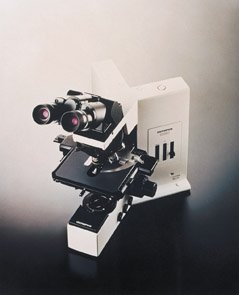Achieving a consistent product in the chemical industry is dependent on every aspect of the production process. The BX microscope series is tailored to research & development and quality control applications with a wide variety of pharmaceutical and industrial goods.
Esther Robertson
The BX60 and BX50 deliver resolution and contrast for a diverse range of chemical studies. They enable manufac-turers to develop pigments that deliver the maximum colour liberation through scattering efficiency or food products that bridge the right number of taste buds. A wide variety of chemical and industrial processes are concerned with particulate matter. Control of the process and of the final product is dependent on various forms of particle analysis. Particle size measurements usually assume the model form of the sphere in the assessment. From this assumption, linear and volume dimensions can be reconciled. In actual fact, shape has a significant impact on the performance of a raw substance and this needs to be identified visually. The only effective means of doing this for many products is by microscopy.
Attention to detail
The BX series incorporates UIS infinity-corrected optics to ensure that light passing into the objective and through the body tube as parallel rays is focused using a built-in telan lens, forming a completely aberration-free intermediate image. The field of view has been extended to F.N. 22 – a 21% increase in the area of coverage over the conventional standard of F.N. 20. This makes the BX series ideal for general-purpose quality control applications as well as specific studies on particulates. These studies can be carried out in comfort as a result of the shape of the BX series frame. Eyepoint height can be adjusted by using one or two 30 mm insertion rings and the observation tube inclined be-tween 5 and 35°.
Electronic storage for reference
Up to three image capture devices can be attached to the BX series, enabling suppliers to demonstrate that they have achieved a consistent product. Users can choose from 35 mm SLR cameras, digital cameras and photomicrographic systems. The DP10 digital camera system allows the direct creation of digital images which can be processed and archived using the database software DP-Soft. This capability is important for quality control applications, allowing a copy of any microscopic test to be stored electronically for future reference. To qualify for ISO 9000 and ISO 9002 accredita-tion, every aspect of the production process needs to be fully validated so that it is repeatable.
Applications of the microscopes
The microscopes in the BX series are employed in the chemical and pharmaceutical industries. They can be used, for example, for examining the purity of a chemical product and identifying the nature of any foreign particles in order to obtain clues to their origin. Quality control managers will be able to review the company’s handling and storage procedures and determine any possible causes of contamination.
Alternatively, users may see an unusually large particle under the microscope, which is an indication that there may have been a problem with the milling process. For example, the grinder may have been overloaded, creating a path for a large particle to drop through. Early identification of such processing problems means that people further down the production chain will not have to reject large quantities of the raw material.
Particle size also affects the way in which the body absorbs pharmaceutical drugs. Patients taking painkillers require both an immediate hit, as provided by small particles with a large surface area combined with a fast chemical reaction rate, and the lasting relief offered by large particles.
In the cement production process, manufacturers actually need to check that they have achieved the right mix of different-sized particles. Reducing their size speeds up the rate at which the cement sets, but adversely affects its longevity. Particle sizing techniques, such as laser diffraction, are frequently used to monitor the production process, but microscopy is used to examine cement clinkers and look more closely at differences in porosity, crystal form and size.
Olympus
Fax: ++49/40/230817
Further information cpp-279
Unsere Webinar-Empfehlung
Der Webcast MTP und modulare Produktion bietet eine einzigartige Gelegenheit, mehr über die aktuellen Entwicklungen bei MTP und in der modularen Produktion zu erfahren.
Chemie- und Pharmaproduktion braucht mehr Flexibilität
In der heutigen sich schnell wandelnden Welt stehen…
Teilen:











